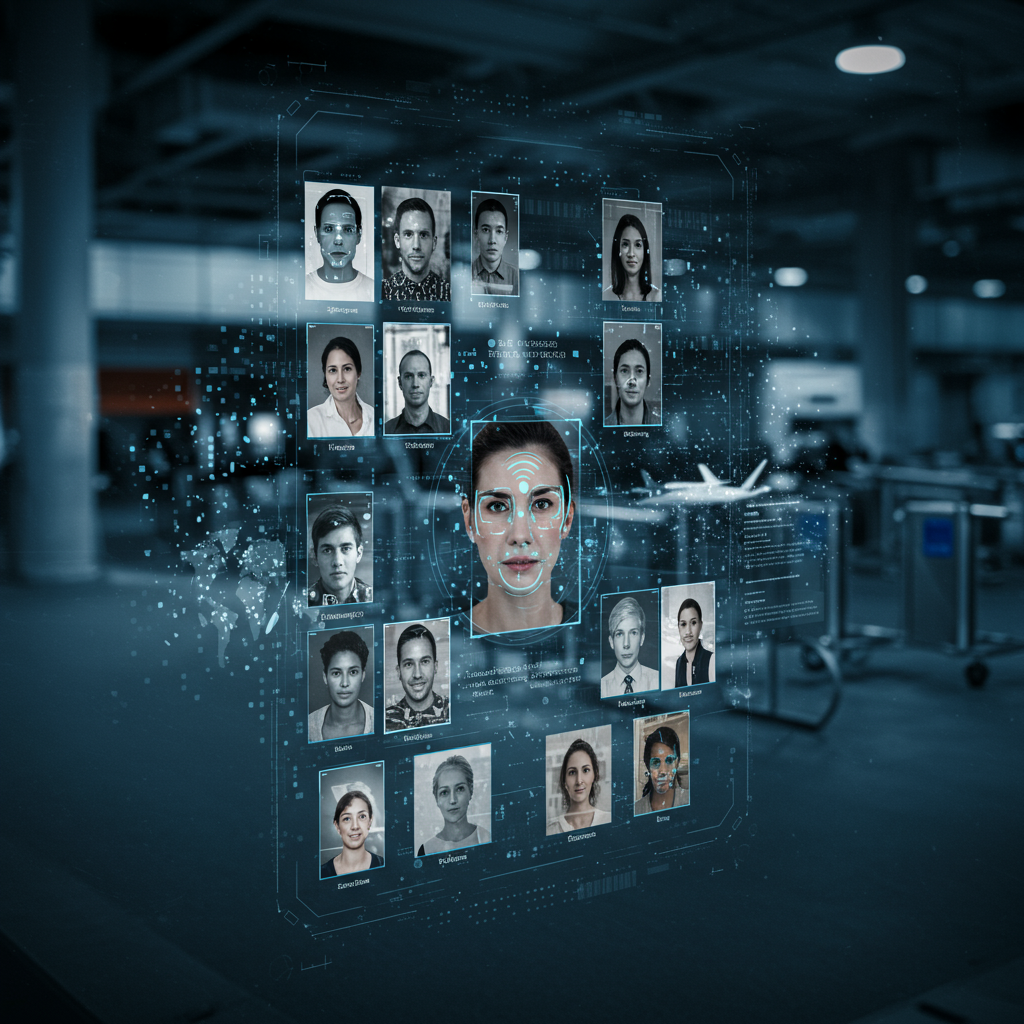Facial recognition technology (FRT) has transformed from a futuristic concept into a pervasive tool. It unlocks our phones, screens airline passengers, and enhances security at major events. But behind its convenience lies a complex narrative of innovation, ethical dilemmas, and a fragmented regulatory landscape. This guide delves into the hidden origins, intricate science, profound societal impact, and critical future of FRT, offering insights into one of the most powerful and controversial AI advancements of our time.
The Secret Genesis: Tracing Facial Recognition’s Roots
The history of facial recognition is far from straightforward, shrouded in secrecy and early government interest. Uncredited pioneer Woodrow “Woody” Wilson Bledsoe laid the groundwork in the 1960s, with his foundational research reportedly bankrolled by the CIA through various front organizations. Bledsoe, driven by a dream of creating a “computer person,” initially grappled with immense technical challenges. Digital image databases were nonexistent, computing power was rudimentary, and human faces presented dynamic variables like rotation, lighting, and expression.
By the mid-1960s, Bledsoe adopted a “man-machine” approach. This method, inspired by Alphonse Bertillon’s anthropometric system, involved human operators taking precise measurements from photographs. His 1965 experiment successfully matched faces by recording 22 measurements from 122 photos. Later, using the RAND tablet, his team processed 2,000 images, demonstrating the method’s potential. Crucially, Bledsoe’s 1967 collaboration with Peter Hart at Stanford Research Institute yielded a system for law enforcement. It could sift through mugshot databases 100 times faster than humans and tolerating aging effects. This groundbreaking paper, however, remained classified, highlighting the technology’s secretive beginnings and the ethical considerations present from its inception, including potential racial identification.
The Science of the Scan: How Facial Recognition Works
Modern facial recognition technology operates through sophisticated artificial intelligence and deep learning algorithms. The core process involves three main stages: detection, alignment, and matching. First, the system detects a face within an image or video feed. Next, it aligns the face, standardizing its position and orientation for accurate analysis. Finally, it extracts unique facial features.
These features, often up to 68 distinct data points, are converted into a unique numerical expression, a “faceprint.” This digital template is then compared against vast databases of stored faceprints. The premise is that all faces are slight deviations of about 128 “standard” faces. Unlike simple photo matching, advanced FRT uses neural networks to learn and adapt, continuously improving its accuracy. The industry, valued at $3.8 billion in 2020, is projected for substantial growth across sectors, fundamentally altering how we interact with the world and how our identities are verified.
From N-Tuple to Neural Networks: A Leap in Capability
Bledsoe’s early “n-tuple method” for pattern recognition laid the conceptual groundwork. Today, deep learning has revolutionized FRT, allowing systems to recognize intricate patterns and nuances that were once impossible. These advanced algorithms analyze features like the distance between eyes, the depth of eye sockets, the shape of cheekbones, and the contours of the lips, creating highly detailed and unique faceprints. This technological leap enables FRT to perform complex tasks, from unlocking smartphones to identifying individuals in large crowds with increasing speed and precision.
Pervasive Reach: Widespread Adoption and Data Harvesting
Facial recognition technology has permeated daily life across various sectors. Over 100 U.S. police departments subscribe to FRT services for criminal investigations, aiding in solving cold cases and locating missing persons. The private sector also leverages FRT for security, access control, and even attendance tracking by employers. Entertainment venues, from major sports arenas to concert halls, are rapidly adopting FRT for security, raising significant questions about surveillance in public spaces.
The scope of FRT databases is staggering. Companies like Clearview AI have reportedly amassed over 30 billion images, often scraped from public social media platforms like Facebook. Consequently, over half of American adults’ faces are now in FRT databases, frequently without their explicit knowledge or consent. This widespread data collection presents unprecedented challenges for personal privacy and data security, as our digital identities become increasingly exposed and exploitable.
Noteworthy Implementations and Controversies
The deployment of FRT has sparked significant public debate. In 2019, Taylor Swift’s security team reportedly used FRT at her “Reputation” tour to identify known stalkers. This undisclosed surveillance raised concerns about consent and secret recording. However, the record-breaking sales of her concerts suggest a public willingness to cede some privacy for their favorite artists. More controversially, James Dolan, owner of Madison Square Garden (MSG) properties, used FRT to deny entry to individuals affiliated with law firms litigating against MSG. This led to lawsuits and intervention from the New York Attorney General, highlighting how FRT can be used to restrict access based on employment or criticism. Similarly, Rite Aid stores were banned from using AI-based surveillance after it repeatedly misidentified people of color as shoplifters, leading to harassment and police calls.
The Double-Edged Sword: Ethical and Societal Concerns
The widespread adoption of facial recognition technology brings with it a host of profound ethical and societal challenges. While proponents highlight its public safety benefits, critics warn of its potential for misuse and discrimination.
The Looming Shadow of Mass Surveillance and Privacy Erosion
A primary concern is the potential for mass surveillance. FRT enables constant monitoring of individuals in public spaces, potentially tracking their movements, associations, and activities without consent. This pervasive surveillance could chill free expression and assembly rights, as people might self-censor knowing they are constantly being watched. The collection of vast biometric datasets by private entities and governments raises fears of misuse, from commercial exploitation to government overreach, particularly given the sensitive nature of biometric data.
Algorithmic Bias: A Flawed Reflection of Humanity
Perhaps the most critical ethical issue is algorithmic bias. FRT algorithms are programmed by humans and trained on human-generated datasets, which often reflect existing societal biases. Research like “The Gender Shades Project” has revealed that FRT software is least accurate for darker-skinned females, with error rates up to 100 times higher for Black and Asian faces compared to white faces. This is primarily because training datasets are heavily skewed towards white males, leading to significant misclassification rates for minority demographics.
The consequences of this bias are severe. Robert Williams, a Black man in Detroit, was wrongfully arrested and detained for 30 hours in 2020 due to an FRT error. Amazon’s Rekognition system, during a pilot with Orlando police, misidentified numerous people of color and even members of Congress as criminals. These incidents underscore that the technological immaturity and inherent biases of FRT can exacerbate existing inequalities and lead to discriminatory actions, even if unintended by developers. The lack of diversity in development teams and insufficient ethics education in computer engineering curricula further perpetuate these biases.
Navigating the Legal Labyrinth: A Fragmented Regulatory Landscape
The United States currently lacks a comprehensive federal regulatory framework for facial recognition technology. This absence has resulted in a “patchwork” of state and municipal laws, creating legal ambiguity and inconsistent protections for individuals. While existing Civil Rights Acts prohibit general discrimination, no specific federal constitutional provisions or laws regulate the federal government’s use of FRT.
Illinois’ Biometric Information Privacy Act (BIPA), enacted in 2008, stands out as a pioneering law. It mandates written notice and consent for biometric data collection and restricts data sale. California’s Consumer Privacy Act (CCPA, 2018) broadly covers facial imagery but operates on an “opt-out” basis, placing the burden on consumers. New York City’s Biometric Identifier Information Protection Code requires commercial establishments to disclose FRT use and prohibits selling or sharing data. However, it still allows data collection and utilization. Cities like San Francisco, Boston, and Portland, Oregon, have gone further, banning government use of FRT altogether. Globally, the European Union Artificial Intelligence Act represents a significant step towards classifying AI by risk and potentially banning FRT in certain contexts, mandating transparency.
Calls for Comprehensive Oversight
Experts widely agree that relying on self-regulation by tech companies is insufficient. Meta’s announcement to shut down Facebook’s facial recognition system, while deleting billions of face-scans, was met with skepticism. Critics argue that the company retains the underlying algorithmic tools for its metaverse projects, suggesting a strategic misdirection rather than a genuine commitment to privacy. This incident, along with others, underscores the urgent need for robust government oversight. Scholars advocate for a federal regulatory framework, potentially involving a dedicated agency to oversee biometric data, inspect systems for bias, and ensure dataset updates. Proposed solutions include requiring regulatory approval for new uses, banning FRT in high-risk contexts, and establishing clear remedial measures for misuse, including private rights of action.
Charting a Responsible Path Forward for Facial Recognition
The future of facial recognition technology hinges on balancing its undeniable utility with robust privacy and civil rights protections. The ongoing tension between security needs, commercial interests, and individual liberties demands careful consideration and proactive measures.
To mitigate the risks, several crucial steps are necessary. Technologically, FRT systems require continuous testing with more diverse datasets, especially images of people of color, to reduce algorithmic bias. Laboratory conditions must also better mirror real-world scenarios to ensure accuracy. Socially, there is a critical need for ethics education within computer engineering curricula. This will equip future developers with the understanding to implement fair and equitable AI systems. Legally, adaptable laws are essential, addressing issues during technology development, not just after deployment.
Empowering Consumers and Strengthening Protections
Consumers remain vulnerable without comprehensive legislation. Future scenarios envision FRT replacing physical tickets, further normalizing constant monitoring. The MSG case serves as a stark warning of how individuals can be denied access based on opaque criteria. While some companies have paused FRT sales to law enforcement, and some artists boycott venues using the technology, larger corporations often continue its use. This highlights the need for systemic change. Ultimately, integrating ethics education across all stakeholders – students, programmers, and policymakers – coupled with a comprehensive federal regulatory framework, is the most powerful solution. This holistic approach can ensure thoughtful, unbiased development, promote ethical awareness, avoid biases, and shape positive policies for a more equitable future for facial recognition technology.
Frequently Asked Questions
What are the core components of how facial recognition technology works?
Facial recognition technology identifies individuals by analyzing unique facial features. The process involves three main stages: detection, alignment, and matching. First, it detects a human face in an image or video. Next, it standardizes the face’s position. Finally, it extracts key facial data points, converting them into a unique numerical “faceprint” which is then compared against a database for identification. Modern systems use deep learning for advanced accuracy.
Which states or cities in the U.S. have enacted specific laws or bans regarding facial recognition?
The U.S. has a fragmented regulatory landscape for facial recognition. Illinois leads with its Biometric Information Privacy Act (BIPA), requiring written notice and consent for data collection. California’s Consumer Privacy Act (CCPA) broadly covers facial imagery. New York City has a code requiring disclosure of FRT use in commercial establishments and prohibiting data sale. Several cities, including San Francisco, Boston, and Portland, Oregon, have implemented outright bans on government use of facial recognition technology.
Should individuals be concerned about facial recognition use in entertainment venues or public spaces?
Yes, individuals should be concerned. The increasing use of facial recognition in entertainment venues and public spaces raises significant privacy concerns, including the potential for mass surveillance and the collection of biometric data without explicit consent. There’s also the risk of algorithmic bias, which can lead to misidentification, particularly for people of color, and discriminatory actions, such as being denied entry based on opaque criteria, as seen in the Madison Square Garden controversies.
Looking for a complete face recognition system in this space?
With our all-in-one Face Recognition, Liveness Detection & KYC Verification System, security is no longer a compromise. You get real users, real identities, and real protection—all in one powerful platform.





